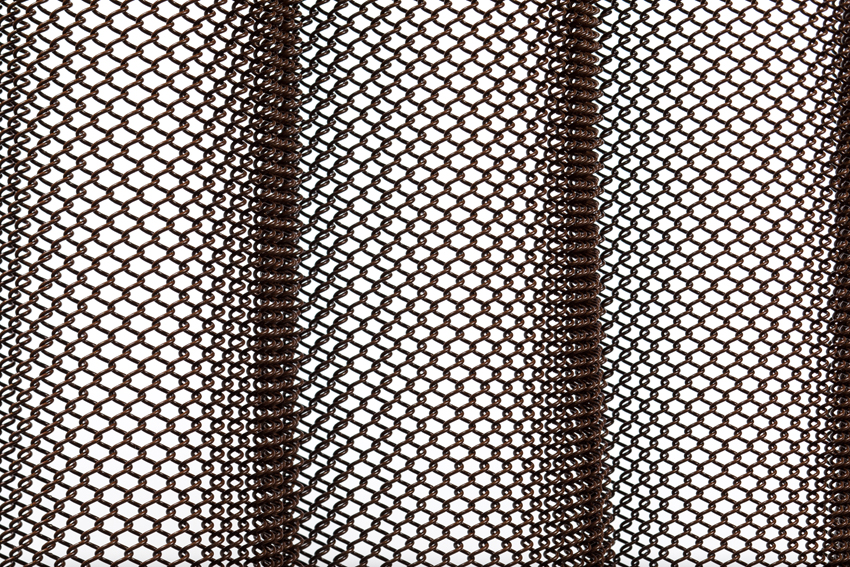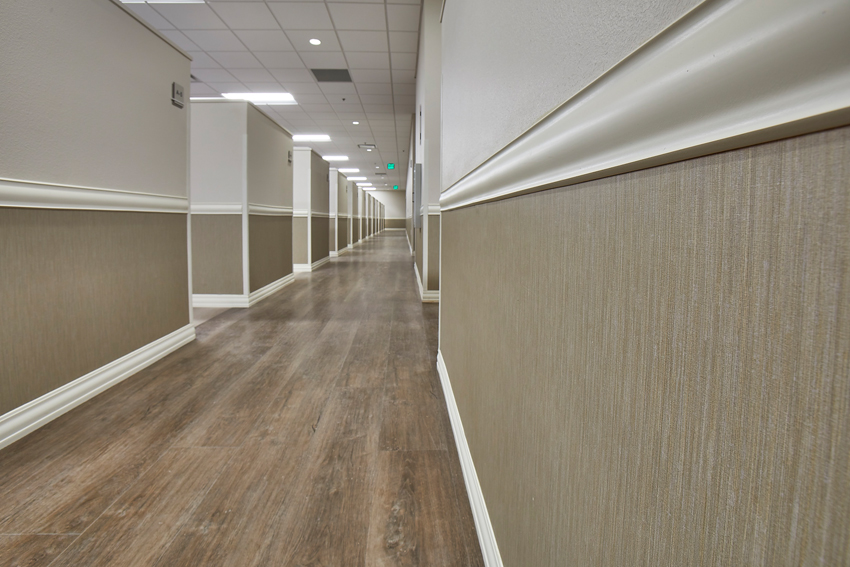Health-Care Design for All
Coiled Wire Fabric Panels
The COVID-19 virus outbreak has spawned an urgent need for medical capacity in many regions. There are many design situations where a need arises to provide a degree of separation for safety or different uses where a solid wall or partition is not needed. In fact, it may even be desirable to provide for some connectivity between spaces for visual, airflow, sound, or other considerations.
Coiled wire fabric panels are an excellent solution for partitioning spaces in health-care facilities. The panels can be used in common areas requiring wayfinding and to create temporary dividers or partitions for check-in stations.
Because the material is so flexible, panels can be straight, curved, or undulating, providing visual interest while performing their important function.
Coiled wire panels are comprised of a base metal wire that is typically available in varieties of steel, aluminum, brass, copper, or stainless steel. They are manufactured by interlocking metal wire coils via a simple corkscrew method; the spirals are woven together to create a flexible metal fabric panel. Panel edges are hand crimped, and the finished panel is secured to the attachment system. Both the wire material and its gauge impact weight, functionality, and aesthetics, so it is important to select these attributes with the project requirements in mind.
Architects and engineers can use coiled wire fabric in building interiors for curtains, ceiling treatments, wallcoverings, security gates, and even as complete partitions. They are available with a range of attachment systems, allowing for different building conditions and finish treatments.
Coiled wire fabric panels provide privacy and delineation, but the nature of the material allows light and air to pass through. This is a key consideration when partitioning rooms, especially in health-care settings. The HVAC system is designed to circulate air so that pathogens do not accumulate in a space. It is critical that partitions or curtains do not interrupt this function.

Photo courtesy of Cascade Architectural
The gauge and fullness of coiled wire fabric panels can be varied to achieve the desired visual effect.
Flexible Wall Protection
Walls in high-occupancy buildings endure continual wear and tear, whether it be from equipment and carts or pedestrian traffic. The most obvious type of impact is that which directly damages drywall, leaving cuts, gouges, or even holes. However, a more subtle form of damage accumulates more slowly in the form of scuffs, marks, and abrasions that eventually create a shabby, worn appearance.
An excellent solution for walls in health-care facilities is flexible wall protection, which combines the look of true wallcovering with the durability of rigid wall protection. This durable, resilient, and easy-to-clean material is available in many patterns, textures, and colors. The surface is nonporous, which makes it a hygienic solution for health-care facilities.
Flexible wall protection is made from vinyl, but it incorporates texture in the material for an appealing and interesting aesthetic. This wall protection is as thick as rigid products and will withstand moderate abuse. In addition, the panels are Class A fire rated.
Health-care facilities must be cleaned frequently and thoroughly, and fixtures, surfaces, and finishes must be able to withstand frequent treatment with strong, broad-spectrum bactericides and virucides.
Here are some of the standards and certifications to consider when specifying interior products:
- ASTM D-543 for chemical resistance; G-21 and G 22 for fungal and bacterial resistance
- AR CE CenterISO 846: Biological resistance and ISO 2812-1: Chemical cleanability
- AR CE CenterGREENGUARD certification for indoor air quality
Proper surface preparation and adhesive is critical to prevent mold behind flexible wall cladding. When tested for use with the U.S. Environmental Protection Agency's (EPA's) approved list of disinfectants, flexible wall protection products showed no change on the surface material or color following exposure to the cleaning agents, such as undiluted household bleach, isopropyl alcohol, and 3 percent hydrogen peroxide.

Photo courtesy of Inpro
Textured solid-surface wallcovering is durable and easy to clean, and it can impart a warm, residential feel to health-care facilities.
The Importance of Lighting in Residential Health-Care Settings
Lighting plays a critical role in health-care facilities. Good lighting design considers illumination levels, color temperature, and color rendering of artificial light sources; it balances ambient and task lighting and artificial and natural light. Effective lighting ensures health-care providers can perform their tasks and help keep patients, residents, and staff safe.
Residential facilities such as assisted-living facilities, nursing homes, and hospice care facilities have particular concerns. On average, residents in these facilities are in their 80s or older. People in this age group experience physiological changes that affect their vision, sleep patterns, and more.
Older people may have poorer vision and a decreased ability to detect color differences; at the same time, they may be more sensitive to glare. They may have trouble reading small print, distinguishing colors, and transitioning between bright and dim spaces. Eye diseases such as glaucoma and cataracts are also more common in this demographic. Degradation of sight and disorders such as Alzheimer’s disease and dementia can disrupt circadian rhythms, which govern sleep cycles and other physiological functions. Alzheimer’s can negatively affect depth perception and peripheral vision. People suffering from Alzheimer’s may not be able to discern brightness contrast, and they may be more sensitive to glare and shadows. These deficiencies can contribute to falls and reduced balance and stability.
Lighting design for long-term care facilities typically emphasizes daylight and higher electric light levels, minimizing glare through indirect light distribution and other means, good uniformity of light distribution, and accent lighting for safety. Transition spaces receive high illumination for visual adaptation. Flicker should be avoided. At the same time, these facilities are not just clinical environments but residences. Consequently, lighting should support the body’s inherent biological circadian rhythms, which depend in part on light and dark cycles. In addition, both the light quality and lighting fixtures should be promote a sense of comfort and “hominess.”
Several standards guide lighting design in health-care facilities. IES RP-28 sets minimum recommended light levels, while the ADA sets limits for how far light fixtures may project from a wall. The Facility Guidelines Institute (FGI) require daylighting in common areas such as dining and activity rooms, while recommending it wherever else possible based on its value for light levels, color quality, and circadian entrainment. The guidelines add that if daylight is not available, electric lighting should promote circadian response, which may be accomplished with intensity and color control in LED luminaires.
LED lighting technology has opened up new possibilities for lighting design that supports health. LEDs can produce “white” light in a range of color temperatures; in addition, newer LEDs have improved color rendering, which is a measure of how they appear under artificial lighting compared to natural light.
Recent studies also underscore the promise of biodynamic LED lighting. Such lighting supports the body’s natural circadian rhythms by mimicking the color temperature and intensity of light as it cycles through the day. “Circadian-friendly” lighting may improve sleep by ensuring adequate levels of “blue” light during the day. This helps regulate the production of melatonin, a key sleep hormone.
Notice

www.aamsco.com/mirrors/wheelchair-medicine-chest

www.cascade-architectural.com

www.inprocorp.com









